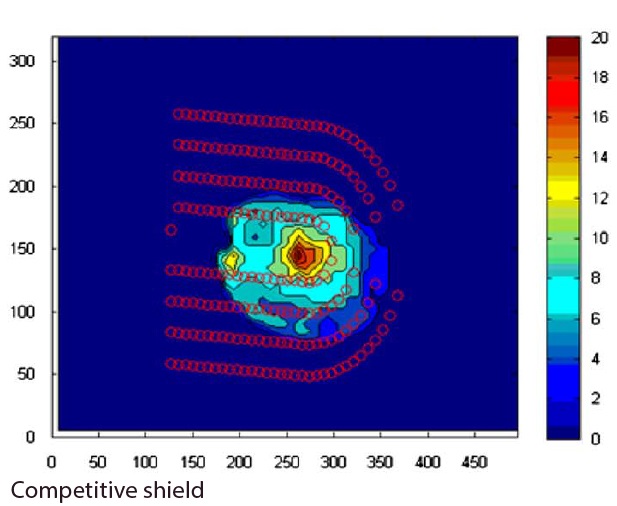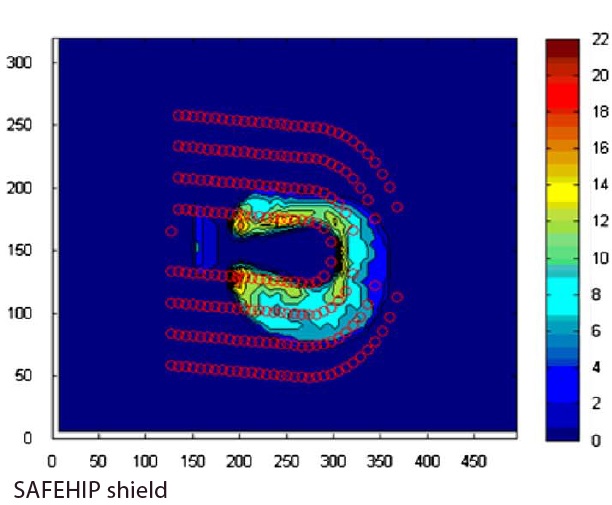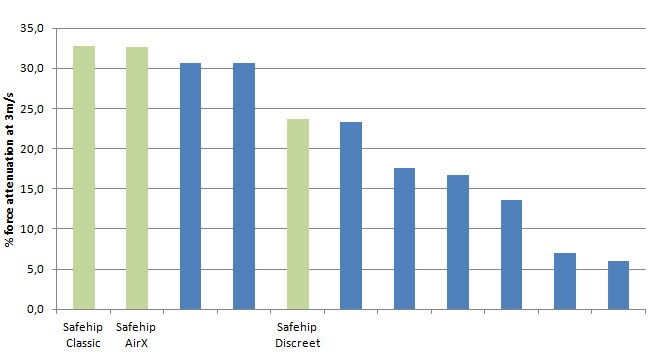WHY IS BIOMECHANICAL TESTING OF SAFEHIP HIP PROTECTORS IMPORTANT?
It is challenging to advocate for the use of hip protectors due to the difficulty in proving their worth. In this context, it is important to know, how hip protectors attenuate force as this ability may prevent a hip fracture. Often, studies of the protective performance of hip protectors bring about diverging results, which leads to uncertainty about how efficient hip protectors are at attenuating the impact of a fall.
WHAT DOES FORCE ATTENUATION MEAN?
Force attenuation as a term is used to indicate the level of protection of a hip protector, meaning to which extent the hip protector reduces the force from a fall, and thereby possibly preventing a hip fracture. The attenuation is measured in biomechanical tests simulating a fall, by comparing the impact on the hip in a non-protected fall versus a protected fall. The result indicates the effectiveness of the protective devices.
The typical test fall speed recommended by experts is 3 m/second, as it is a velocity representing a fall that is more severe than normal, yet within the measured range for elderly (1). Normally, it is assumed that elderly do not fall at such a high speed (2), but by testing shields at a speed higher than average, yet still within the measured fall speed range for older people, a worst-case scenario is created, where the shields have to “overperform”, and this further adds to the assurance that the shields will work in a real fall case
SAFEHIP® SHIELDS AND FORCE ATTENUATION
We know for a fact that the shape of our Safehip horseshoe protector shields with the hole in the middle makes it difficult to explain the advantage of this over the classic fully covering type of hip protector shields. The aim of the biomechanical tests is to prove exactly this – that by not covering the critical spot on the hip, the hip protector shield becomes more effective
Unfortunately, a general, global agreement on biomechanical testing standards does not exist, but the “Injury Prevention and Mobility Laboratory”, located in Canada and one of the most renowned, recognized and respected shield test laboratory institutes in the world, uses innovative approaches such as video capture and wearable sensors to determine the causes and circumstances of falls of older adults. The team at the laboratory also develops and tests the effectiveness of engineering interventions, such as protective clothing and compliant flooring in reducing fall-related injuries (3).
This Canadian test laboratory institute has been carefully selected to test Safehip shields, to completely ensure that the function of the shields is not compromised.
FORCE ATTENUATION ABILITY TESTS OF SAFEHIP® AND COMPETITORS
TEST ONE
Below is shown a comparative efficacy test carried out by the Canadian test laboratory institute. The test compares the horseshoe-shaped Safehip hip protector shield and a competitive hip protector shield that covers the fragile spot on the femoral bone.
The aim with the test is to determine which of the two hip protector shields attenuates the force from a fall most efficiently to prevent a hip fracture: The shield that covers the fragile spot on the femoral bone, or the Safehip shield positioned around the fragile spot.
The horseshoe shaped shields distribute the energy from a fall to the tissue around and not directly onto the fragile spot on the femoral bone, that is prone to energy impact in case of a fall. This fragile spot is covered by material in most other competitive hip protectors.
The colour scale to the right indicates the force of a fall. The red, orange and yellow colours at the top of the colour scale represent high energy impact, where particularly the red colours represent highest impact in case of a fall, whereas the bluish colours at the bottom of the colour scale illustrate low energy impact.
Imagine that a user of a hip protector has just fallen and is lying on the side. On the below picture to the left, he is wearing a competitive hip protector pant and on the picture to the right he is wearing a Safehip hip protector pant (the graphic red lines serve as marking lines for interpreting test results).
When exposed to the force of a fall, the competitive hip protector shield (left) covering the fragile spot may not offer adequate protection causing trauma to it. This is illustrated by the red, orange and yellow colours located exactly where the fragile spot on the femoral bone is. It is not difficult to see that no force is applied on the fragile spot located in the hole in the horseshoe shaped Safehip shield to the right. Instead, the force is dispersed to the soft tissue surrounding the fragile spot.


Source: ”The effect of positioning on the biomechanical performance of soft shell hip protectors”, Choi W.J. et al, Journal of Biomechanics 43, 2010, p. 818-825.
TEST TWO
The above test only includes one competitive product, but the test laboratory in Canada also made a comparison of Safehip and 7 other competitive hip protector shields where the force attenuation was tested. Subsequently, all hip protectors were ranked according to force attenuation performance.
The Safehip hip protectors in test were Safehip Classic, Safehip AirX and Safehip Discreet. In the graph below, all Safehip shields rank in top 5, where Safehip Classic and AirX are equally protective, both taking up the position as number one compared to Safehip Discreet and the other hip protector shields that have been tested.
This means that Safehip Classic and AirX shields show outstanding and Safehip Discreet genuine, above-average force attenuation performance, when exposed to a fall at 3 m/second.

Source: Injury Prevention and Mobility Laboratory, Simon Fraser University, Burnaby, British Columbia, 2017.
SAFEHIP® SHIELDS ARE BIOMECHANICALLY PROVEN TO WORK
As stated above, the aim of the biomechanical tests is to prove that by not covering the critical spot on the hip, the hip protector shield becomes more effective – and the results speak for themselves: All Safehip shields have not only been proven effective by one of the leading hip protection test laboratories in the world, they also rank in top 5 when compared to a range of competitors. This is the best proof, we can get.
(1) "Hip protectors – Express Document”, CSA Group, Exp-08-17, 2017, p. 22, http://shop.csa.ca
(2) "Kinematic analysis of video-captured falls experienced by older adults”, Choi W.J. et al, Journal of Biomechanics 48, 2015, p. 911-920
FOLLOW US
At Tytex we cherish input from our users. We want to hear and learn from your story - so please connect and share



